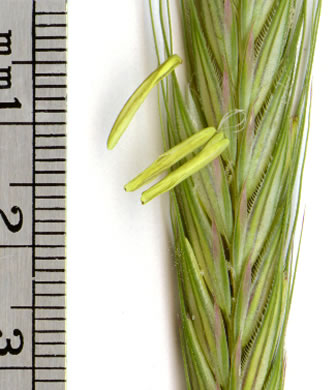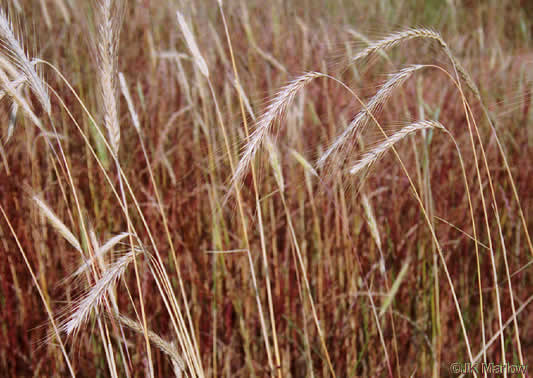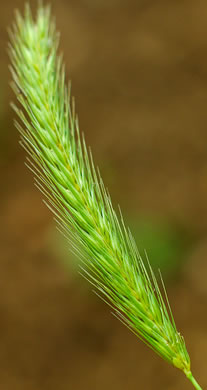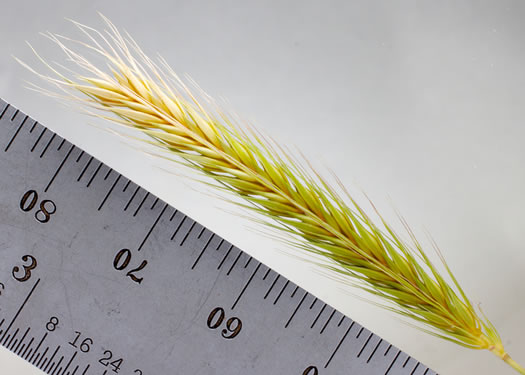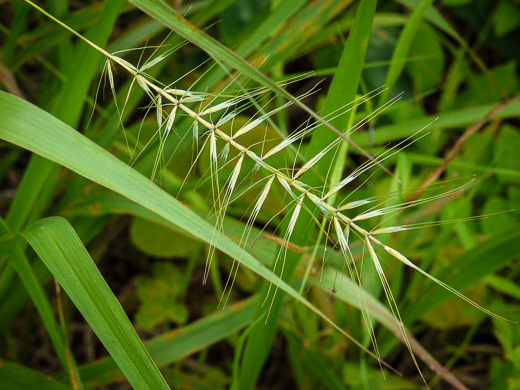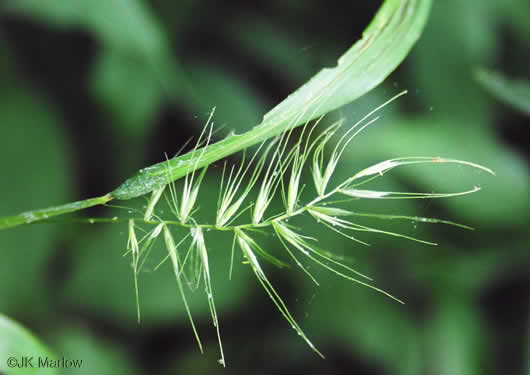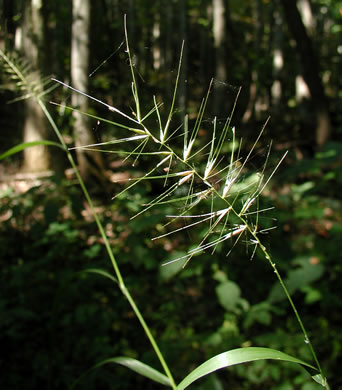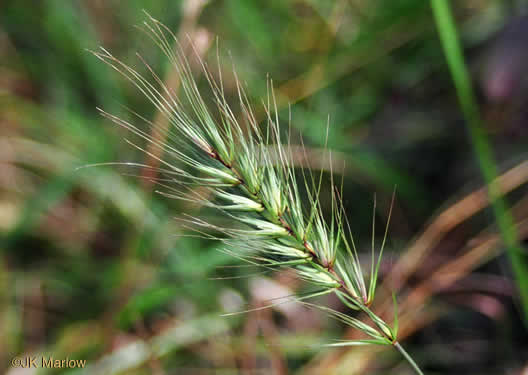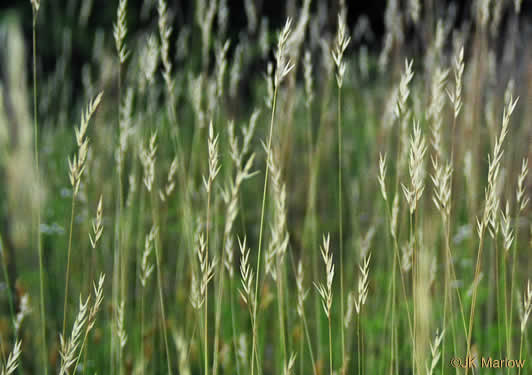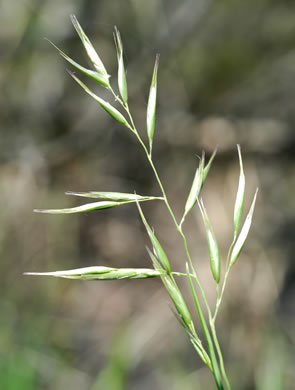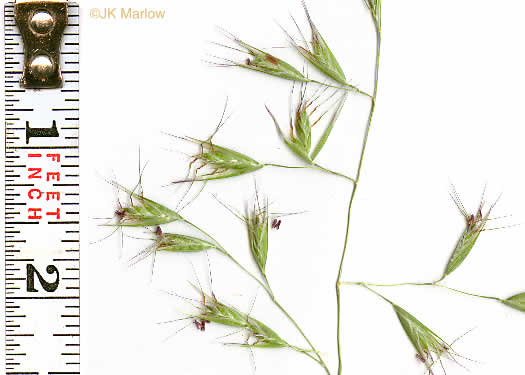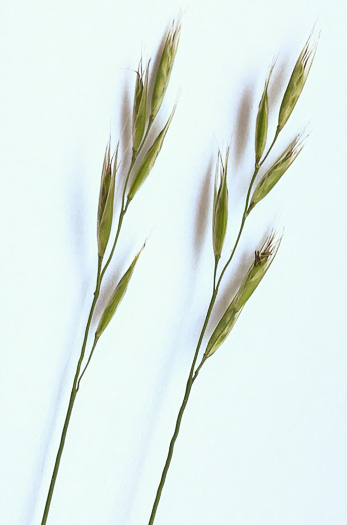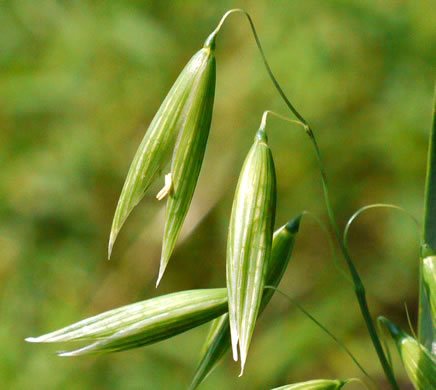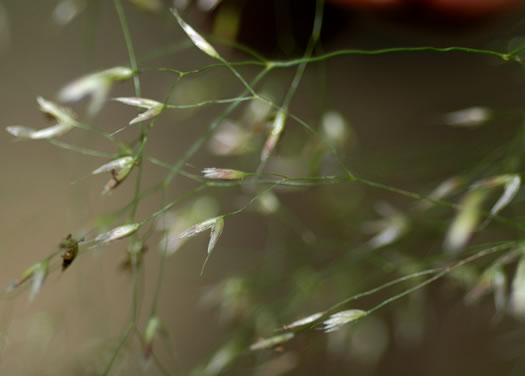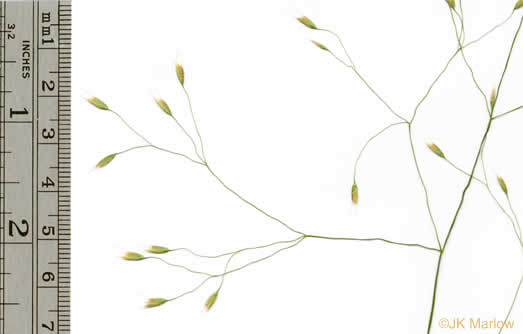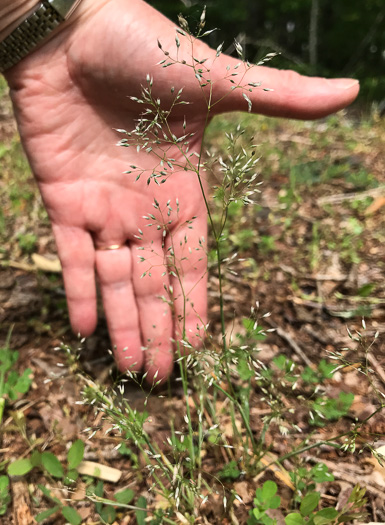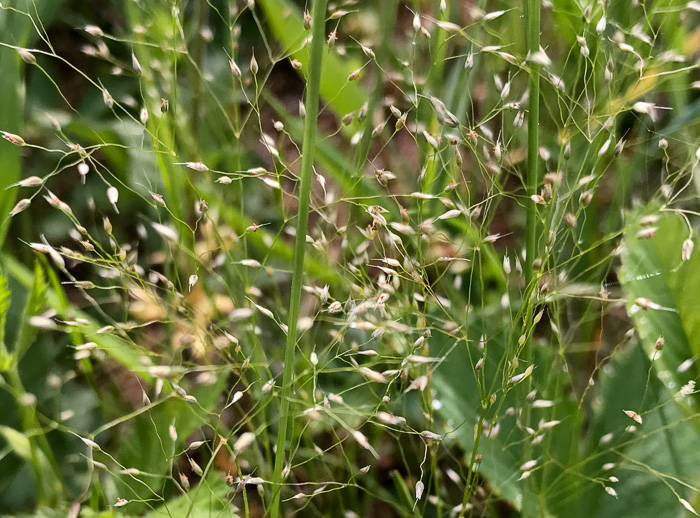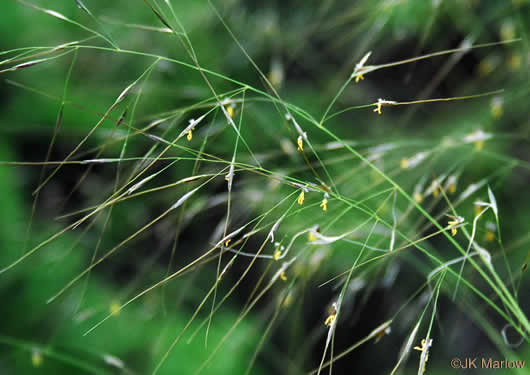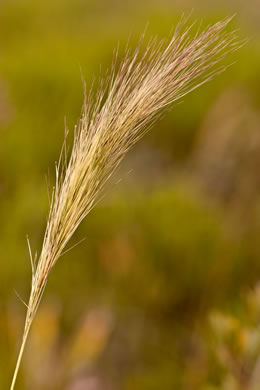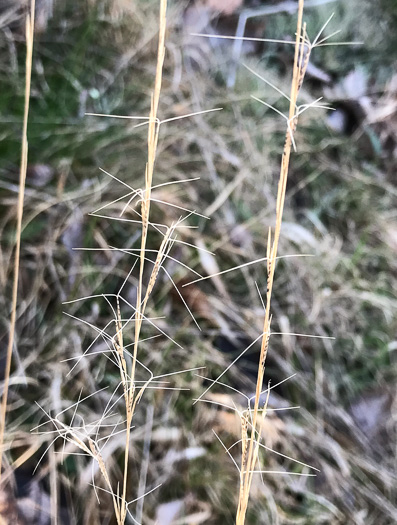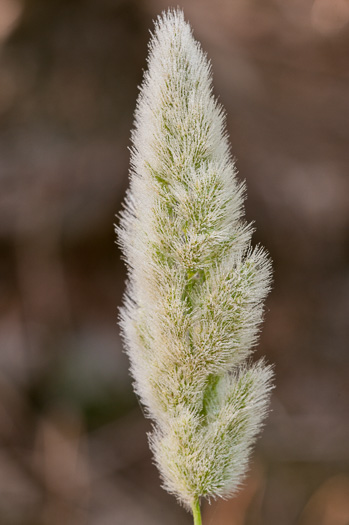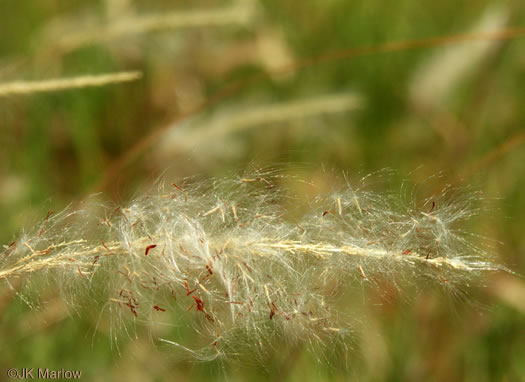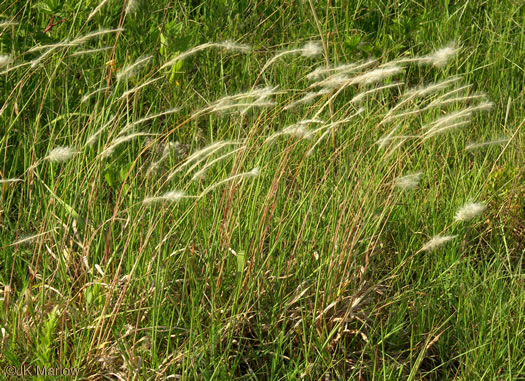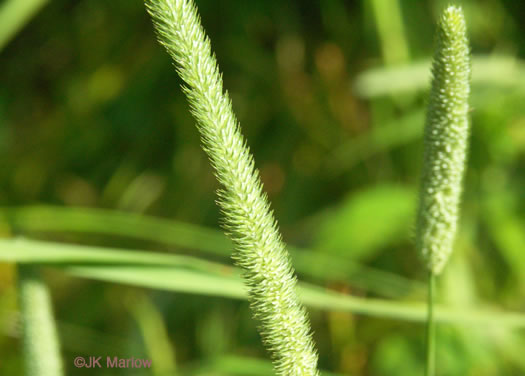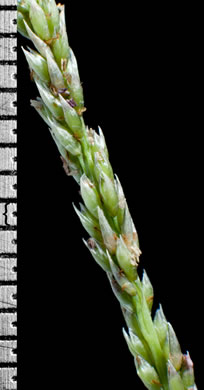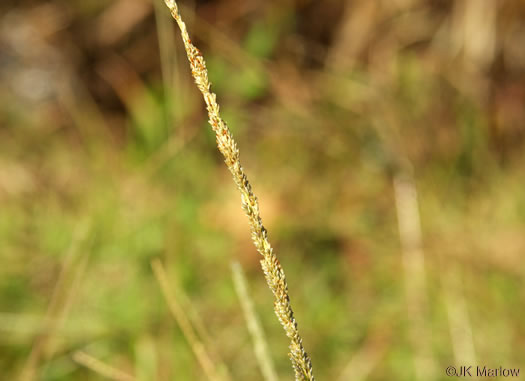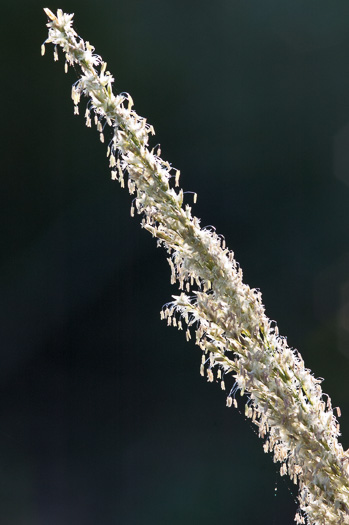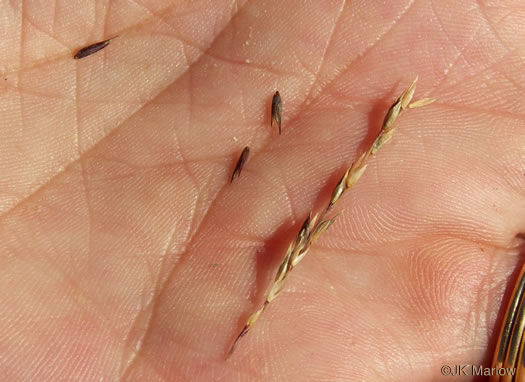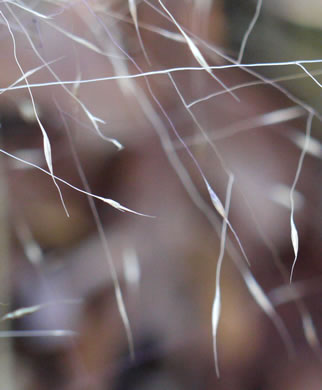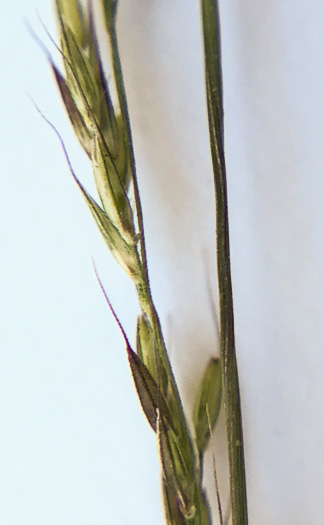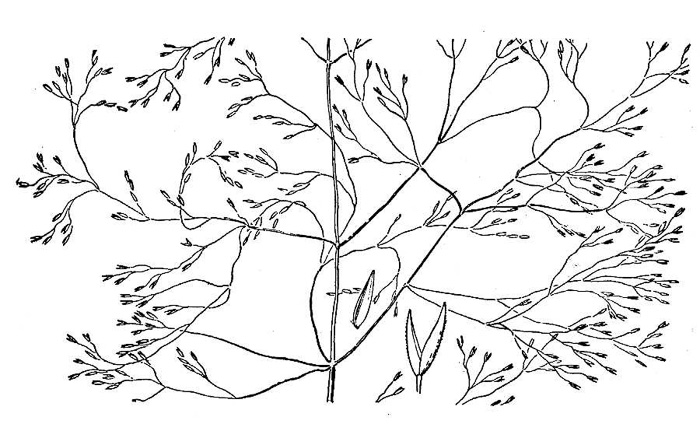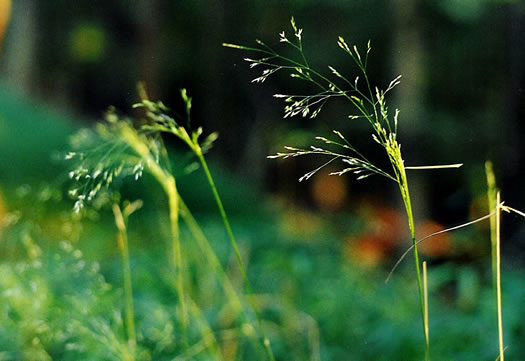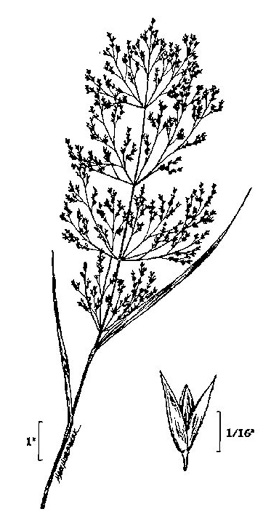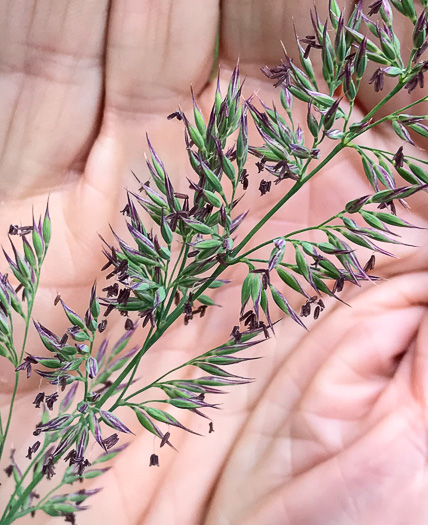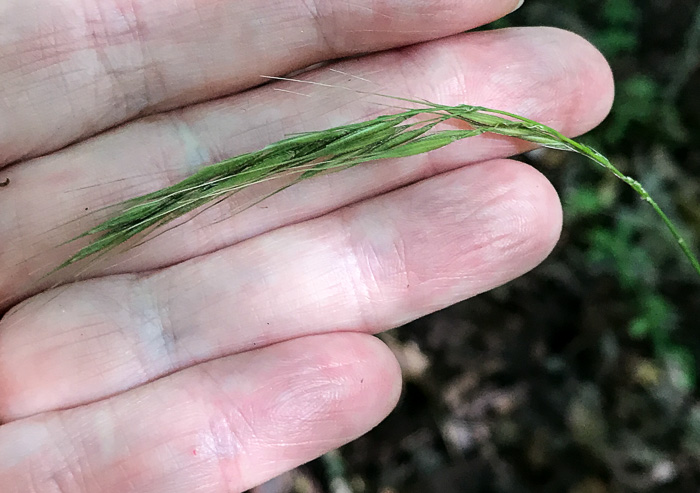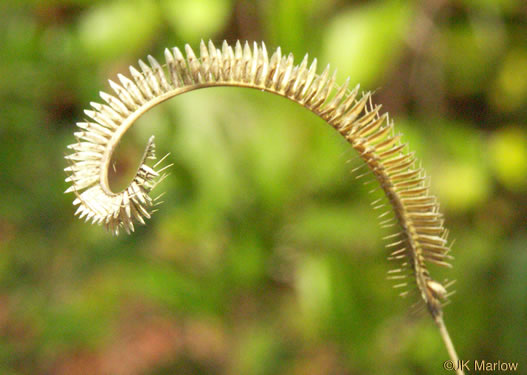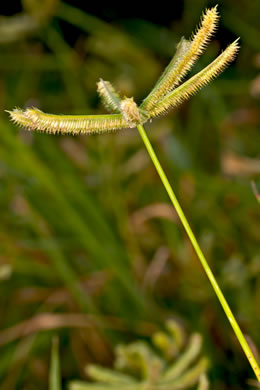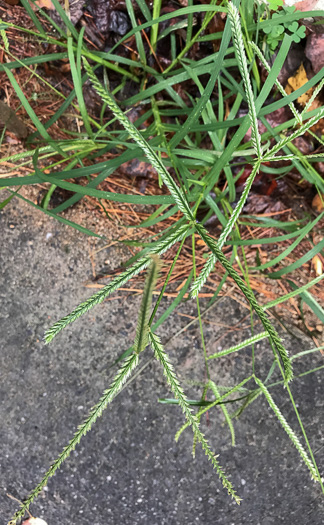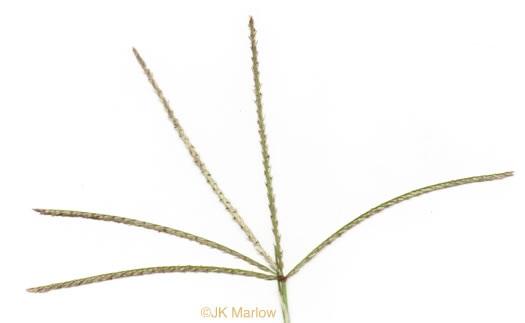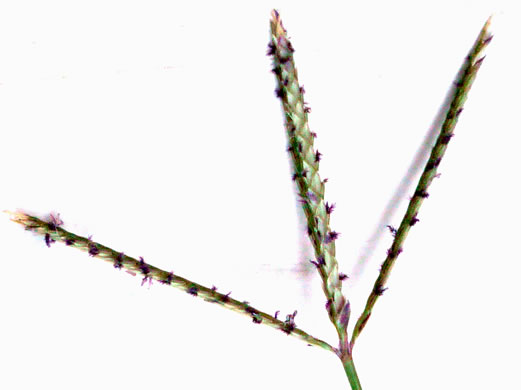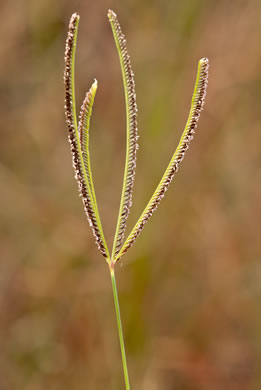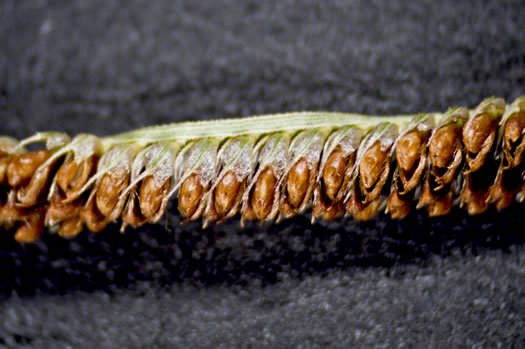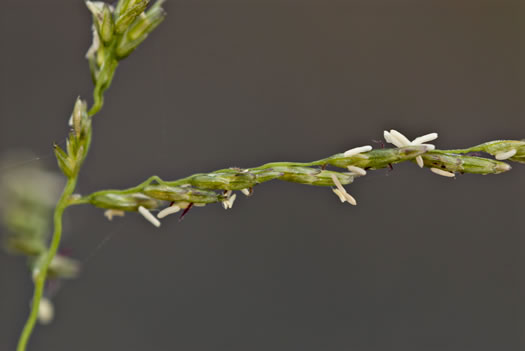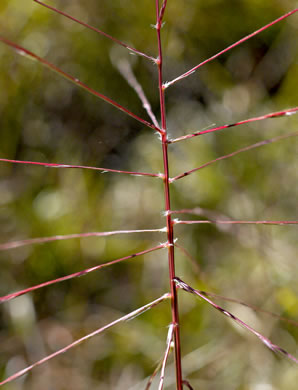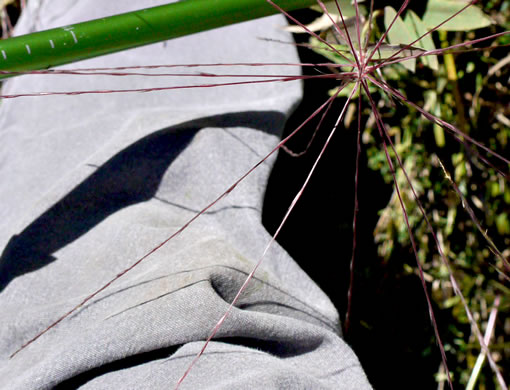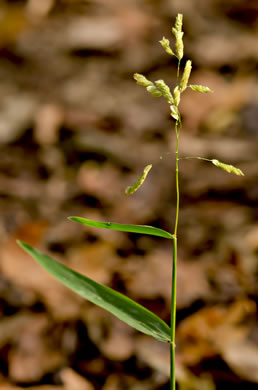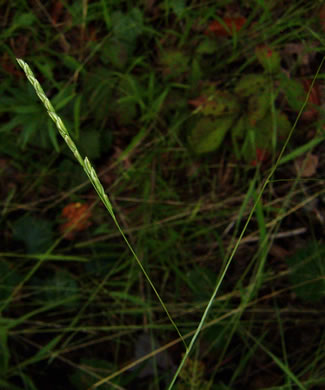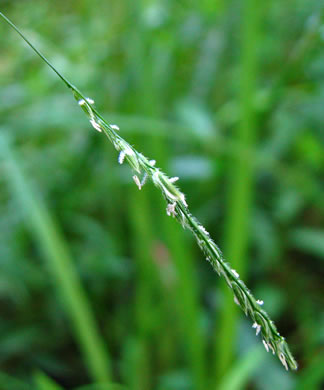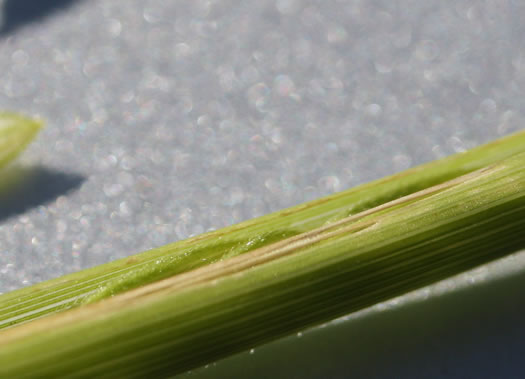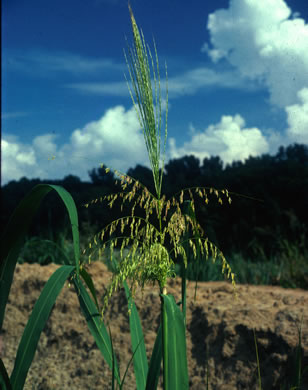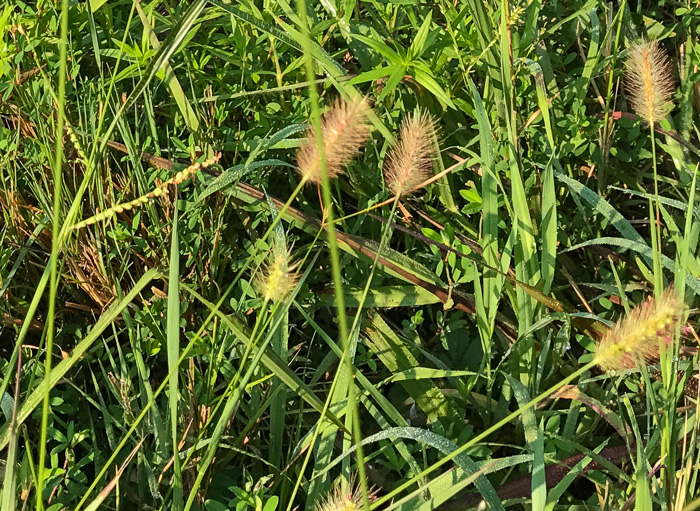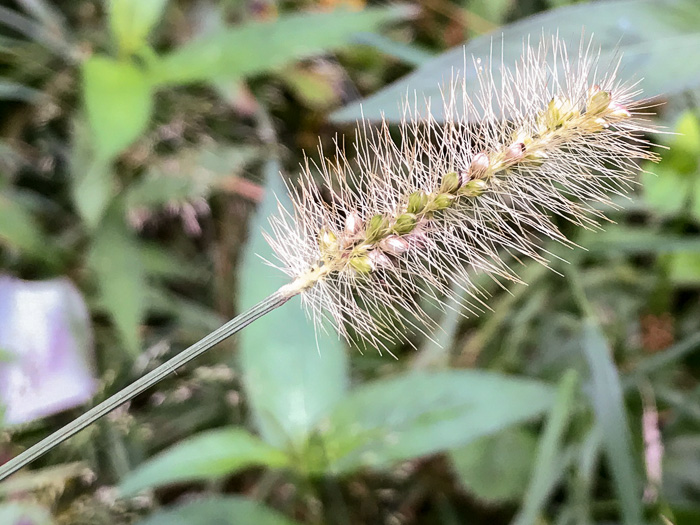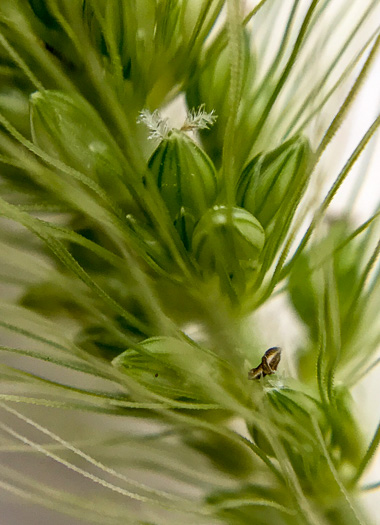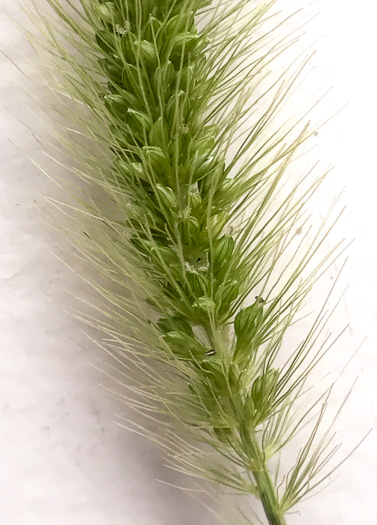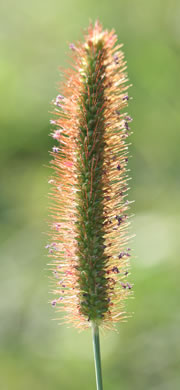Your search found 423 image(s) illustrating the term "spike." For a written explanation, click on "spike" in the Glossary.
PAGE 1 PAGE 2 PAGE 3 PAGE 4 PAGE 5 PAGE 6 PAGE 7 PAGE 8
To see larger pictures, click or hover over the thumbnails.
To go to the plant's detail page, click its name.
 Cereal Rye,
Secale cereale
Cereal Rye,
Secale cereale
Spikelets alternate on opposite sides of rachis, mostly 2-flowered, per Vascular Flora of the Carolinas (Radford, Ahles, & Bell, 1968).
 Cereal Rye,
Secale cereale
Cereal Rye,
Secale cereale
In habit resembling wheat, but usually taller, spike more slender, nodding, per Manual of the Grasses of the United States (Hitchcock & Chase, 1950).
 Little Barley,
Hordeum pusillum
Little Barley,
Hordeum pusillum
Spikelet clusters alternate on opposite sides of the rachis, per Vascular Flora of the Carolinas (Radford, Ahles, & Bell, 1968).
 Little Barley,
Hordeum pusillum
Little Barley,
Hordeum pusillum
Spikes 2-8cm long, 5-7mm broad, per Vascular Flora of the Carolinas (Radford, Ahles, & Bell, 1968).
 Common Bottlebrush Grass,
Elymus hystrix var. hystrix
Common Bottlebrush Grass,
Elymus hystrix var. hystrix
Awned spikelets spread at right angles to rachis; glumes absent or reduced, per How to Know the Grasses: Pictured Key Nature Series (Pohl, 1954).
 Common Bottlebrush Grass,
Elymus hystrix var. hystrix
Common Bottlebrush Grass,
Elymus hystrix var. hystrix
Spikelets usually 2 per node of rachis, usually horizontally divergent, per Vascular Flora of the Carolinas (Radford, Ahles, & Bell, 1968).
 Common Bottlebrush Grass,
Elymus hystrix var. hystrix
Common Bottlebrush Grass,
Elymus hystrix var. hystrix
Rachis internodes 5-10mm, spikelets horizontally spreading toward maturity, per Manual of the Grasses of the United States (Hitchcock & Chase, 1950).
 Virginia Wild-rye,
Elymus virginicus
Virginia Wild-rye,
Elymus virginicus
Elymus species' spikelets are sessile, usually in 2s, alternating on spike, per Wildflowers of the Eastern United States (Duncan & Duncan, 1999).
 Velvet-grass,
Holcus lanatus
Velvet-grass,
Holcus lanatus
Panicle dense, branches spreading and ascending, villous. Spikelets 2-flowered, per Vascular Flora of the Carolinas (Radford, Ahles, & Bell, 1968).
 Silky Oatgrass,
Danthonia sericea
Silky Oatgrass,
Danthonia sericea
Panicle 5-10cm long, relatively many-flowered, the branches bearing 2-6 spikelets, per Manual of the Grasses of the United States (Hitchcock & Chase, 1950).
 Bog Oatgrass,
Danthonia epilis
Bog Oatgrass,
Danthonia epilis
Panicle 5-10cm long, relatively many-flowered, the branches bearing 2-6 spikelets, per Manual of the Grasses of the United States (Hitchcock & Chase, 1950).
 Mountain Oatgrass,
Danthonia compressa
Mountain Oatgrass,
Danthonia compressa
Slender branches bearing 2-3 spikelets, looser than D. spicata, per Manual of the Grasses of the United States (Hitchcock & Chase, 1950).
 Poverty Oatgrass,
Danthonia spicata
Poverty Oatgrass,
Danthonia spicata
Panicle 2-5cm long, the stiff short branches bearing a single spikelet, per Manual of the Grasses of the United States (Hitchcock & Chase, 1950).
 Domestic Oats,
Avena sativa
Domestic Oats,
Avena sativa
Spikelets 15-30mm long, 6-10mm wide. Glumes usually 9-nerved, glabrous, per Vascular Flora of the Carolinas (Radford, Ahles, & Bell, 1968).
 Appalachian Hairgrass,
Avenella flexuosa
Appalachian Hairgrass,
Avenella flexuosa
Spikelets have 2 fertile flowers, each with a lemma with a striking bent awn, per Wildflowers & Plant Communities of the Southern Appalachian Mountains and Piedmont (Spira, 2011).
 Appalachian Hairgrass,
Avenella flexuosa
Appalachian Hairgrass,
Avenella flexuosa
Loose open inflorescence with spikelets at tips of long flexible branches, per Wildflowers & Plant Communities of the Southern Appalachian Mountains and Piedmont (Spira, 2011).
 Silver Hairgrass,
Aira caryophyllea
Silver Hairgrass,
Aira caryophyllea
Pedicels usually 1-2× as long as the spikelets (vs. 2-8× in A. elegans), per Weakley's Flora (2020).
 Elegant Hairgrass,
Aira elegans
Elegant Hairgrass,
Aira elegans
Pedicels usually 2-8× long as spikelets; upper lemma awn 1.5-2.5mm, per Weakley's Flora (2020).
 Green Needlegrass,
Piptochaetium avenaceum
Green Needlegrass,
Piptochaetium avenaceum
Panicle's slender branches 2-4cm long, each bearing 1 or 2 spikelets, per Manual of the Grasses of the United States (Hitchcock & Chase, 1950).
 Bottlebrush Three-awn,
Aristida spiciformis var. spiciformis
Bottlebrush Three-awn,
Aristida spiciformis var. spiciformis
Panicle erect, dense, spikelike, more or less spirally twisted, per Manual of the Grasses of the United States (Hitchcock & Chase, 1950).
 Arrowfeather,
Aristida purpurascens
Arrowfeather,
Aristida purpurascens
Spikelets with 3 straight to spreading awns, 12-25mm long, per Forest Plants of the Southeast and Their Wildlife Uses (Miller & Miller, 2005).
 Annual Rabbitfoot Grass,
Polypogon monspeliensis
Annual Rabbitfoot Grass,
Polypogon monspeliensis
Panicle dense, spikelike, 2-15cm long, 1-2cm wide, per Manual of the Grasses of the United States (Hitchcock & Chase, 1950).
 Cogongrass,
Imperata cylindrica
Cogongrass,
Imperata cylindrica
Spikelike, tightly branched panicle. Spikelets obscured by silky hairs, per Nonnative Invasive Plants of Southern Forests (Miller, 2003).
 Cogongrass,
Imperata cylindrica
Cogongrass,
Imperata cylindrica
Silky spikelike panicles are terminal, cylindrical, 1-8" long, 0.2-1" wide, per Nonnative Invasive Plants of Southern Forests (Miller, 2003).
 Timothy,
Phleum pratense ssp. pratense
Timothy,
Phleum pratense ssp. pratense
Panicle dense spikelike, cylindrical. Spikelets strongly flattened, 1-flowered, per Vascular Flora of the Carolinas (Radford, Ahles, & Bell, 1968).
 Smut-grass,
Sporobolus indicus
Smut-grass,
Sporobolus indicus
Sporobolus is one of many genera with one floret per spikelet, per Wildflowers of the Eastern United States (Duncan & Duncan, 1999).
 Smut-grass,
Sporobolus indicus
Smut-grass,
Sporobolus indicus
Panicle usually spikelike but more or less interrupted, per Manual of the Grasses of the United States (Hitchcock & Chase, 1950).
 West Indian Dropseed,
Sporobolus jacquemontii
West Indian Dropseed,
Sporobolus jacquemontii
Primary branches appressed to strongly ascending, spikelet-bearing to base, per Grass Manual on the Web.
 Rough Dropseed,
Sporobolus clandestinus
Rough Dropseed,
Sporobolus clandestinus
Spikelets 4-8mm. Lemma pubescent, usually conspicuously shorter than palea, per Weakley's Flora (2020).
 Pink Muhlygrass,
Muhlenbergia capillaris
Pink Muhlygrass,
Muhlenbergia capillaris
Spikelets one-flowered, awns 3-12mm long, per Vascular Flora of the Carolinas (Radford, Ahles, & Bell, 1968).
 Nimblewill,
Muhlenbergia schreberi
Nimblewill,
Muhlenbergia schreberi
Ear [inflorescence] 5" long; earlet [spikelet] sharp pointed with 1 long awn, per Field Guide to the Grasses, Sedges & Rushes of the US (Knobel, 1899) (Faust, 1977).
 Nimblewill,
Muhlenbergia schreberi
Nimblewill,
Muhlenbergia schreberi
Spikelets one-flowered, the rachilla disarticulating above the glumes, per Manual of the Grasses of the United States (Hitchcock & Chase, 1950).
 Autumn Bentgrass,
Agrostis perennans
Autumn Bentgrass,
Agrostis perennans
Spikelets usually not clustered near the tips of the branchlets, per Weakley's Flora (2012).
 Autumn Bentgrass,
Agrostis perennans
Autumn Bentgrass,
Agrostis perennans
Spikelets scattered, but absent from the basal portion of panicle branches, per Wildflowers of the Eastern United States (Duncan & Duncan, 1999).
 Coastal Bog Bentgrass,
Agrostis altissima
Coastal Bog Bentgrass,
Agrostis altissima
Spikelets usually clustered near the tips of the branchlets, per Weakley's Flora (2012).
 Nuttall's Reedgrass,
Greeneochloa coarctata
Nuttall's Reedgrass,
Greeneochloa coarctata
Spikelets 1-flowered. Glumes 6-7mm long, scabrous, long-acuminate, per The Grasses of North Carolina (Blomquist, 1948).
 Bearded Shorthusk,
Brachyelytrum erectum
Bearded Shorthusk,
Brachyelytrum erectum
Inflorescence ~ 4-7" long, spikelets strongly ascending with very long awns, per Vascular Plants of North Carolina.
 Toothache Grass,
Ctenium aromaticum
Toothache Grass,
Ctenium aromaticum
A recurved 1-sided spike bearing spikelets in 2 rows, with conspicuous awns, per Atlantic Coastal Plain Wildflowers (Nelson, 2006).
 Toothache Grass,
Ctenium aromaticum
Toothache Grass,
Ctenium aromaticum
Flowers on only one side of the spike, each with awns, looking comblike, per Wildflowers of the Sandhills Region (Sorrie, 2011).
 Florida Toothache Grass,
Ctenium floridanum
Florida Toothache Grass,
Ctenium floridanum
Spikelets pectinately arranged on one side of a continuous rachis, per Manual of the Grasses of the United States (Hitchcock & Chase, 1950).
 Crowfoot Grass,
Dactyloctenium aegyptium
Crowfoot Grass,
Dactyloctenium aegyptium
Rachis end projects in a point beyond spikelets, which lie along one side, per Manual of the Grasses of the United States (Hitchcock & Chase, 1950).
 Goosegrass,
Eleusine indica
Goosegrass,
Eleusine indica
Spikelets in 2 rows on one side of spikes, lemmas and glumes awnless, per Wildflowers of the Eastern United States (Duncan & Duncan, 1999).
 Bermuda Grass,
Cynodon dactylon
Bermuda Grass,
Cynodon dactylon
Several slender spikes digitate at the summit of the upright culms, per Manual of the Grasses of the United States (Hitchcock & Chase, 1950).
 Bermuda Grass,
Cynodon dactylon
Bermuda Grass,
Cynodon dactylon
Spikelets 1-flowered, awnless, sessile in 2 rows along one side of rachis, per Manual of the Grasses of the United States (Hitchcock & Chase, 1950).
 Dune Fingergrass,
Eustachys petraea
Dune Fingergrass,
Eustachys petraea
3-6 spikes arise at about the same point at stem end. Stems often decumbent, per Wildflowers of the Eastern United States (Duncan & Duncan, 1999).
 Dune Fingergrass,
Eustachys petraea
Dune Fingergrass,
Eustachys petraea
Spikelets closely arranged on 2 sides of a 3-sided spike, per Wildflowers of the Eastern United States (Duncan & Duncan, 1999).
 Green Sprangletop,
Disakisperma dubium
Green Sprangletop,
Disakisperma dubium
Seedhead branches triangular in cross-section. Spikelets have 4-7 florets, per Yavapai County Native & Naturalized Plants.
 Eastern Skeletongrass,
Gymnopogon ambiguus
Eastern Skeletongrass,
Gymnopogon ambiguus
Long slender divergent or reflexed spikes set close on a slender stiff axis, per Manual of the Grasses of the United States (Hitchcock & Chase, 1950).
 Eastern Skeletongrass,
Gymnopogon ambiguus
Eastern Skeletongrass,
Gymnopogon ambiguus
Spikes 10-20cm long, per Manual of the Grasses of the United States (Hitchcock & Chase, 1950).
 Catchfly Cutgrass,
Leersia lenticularis
Catchfly Cutgrass,
Leersia lenticularis
Blades lax, 1-2cm wide. Panicle open; spikelets closely imbricate, per Manual of the Grasses of the United States (Hitchcock & Chase, 1950).
 White Cutgrass,
Leersia virginica
White Cutgrass,
Leersia virginica
Spikelets oblong, closely appressed to the branchlets, per Manual of the Grasses of the United States (Hitchcock & Chase, 1950).
 White Cutgrass,
Leersia virginica
White Cutgrass,
Leersia virginica
Leersia's spikelets are one-flowered, strongly compressed laterally, per Manual of the Grasses of the United States (Hitchcock & Chase, 1950).
 Rice Cutgrass,
Leersia oryzoides
Rice Cutgrass,
Leersia oryzoides
Spikelets elliptic, sparsely hispidulous, per Manual of the Grasses of the United States (Hitchcock & Chase, 1950).
 Rice Cutgrass,
Leersia oryzoides
Rice Cutgrass,
Leersia oryzoides
Axillary panicles partly included in the sheaths, spikelets cleistogamous, per Manual of the Grasses of the United States (Hitchcock & Chase, 1950).
 Southern Wild-rice,
Zizania aquatica var. aquatica
Southern Wild-rice,
Zizania aquatica var. aquatica
Erect upper branches with female spikelets, spreading lower branches w male, per Wildflowers of the Eastern United States (Duncan & Duncan, 1999).
 Perennial Foxtail-grass,
Setaria parviflora
Perennial Foxtail-grass,
Setaria parviflora
Flowers in a spike-like panicle 0.5-3cm wide, yellow or purplish, per Forest Plants of the Southeast and Their Wildlife Uses (Miller & Miller, 2005).
 Perennial Foxtail-grass,
Setaria parviflora
Perennial Foxtail-grass,
Setaria parviflora
Spikelets 2-2.5 or even 3mm long; bristles 1-3x or even 6x long as spikelet, per Manual of the Grasses of the United States (Hitchcock & Chase, 1950).
 Yellow Foxtail,
Setaria pumila
Yellow Foxtail,
Setaria pumila
Longer bristles 2-3x as long as the spikelet, per Manual of the Grasses of the United States (Hitchcock & Chase, 1950).
 Yellow Foxtail,
Setaria pumila
Yellow Foxtail,
Setaria pumila
4-12 bristles below each spikelet, per Weakley's Flora (2020).
 Yellow Foxtail,
Setaria pumila
Yellow Foxtail,
Setaria pumila
Panicle dense, evenly cylindric, spikelike, yellow at maturity, per Manual of the Grasses of the United States (Hitchcock & Chase, 1950).

